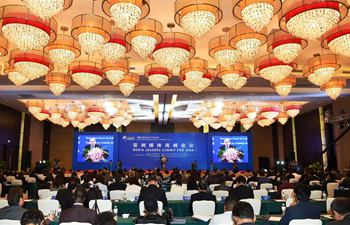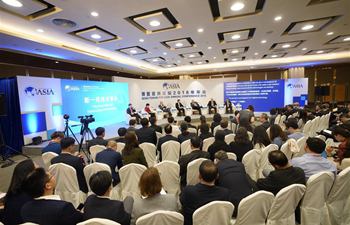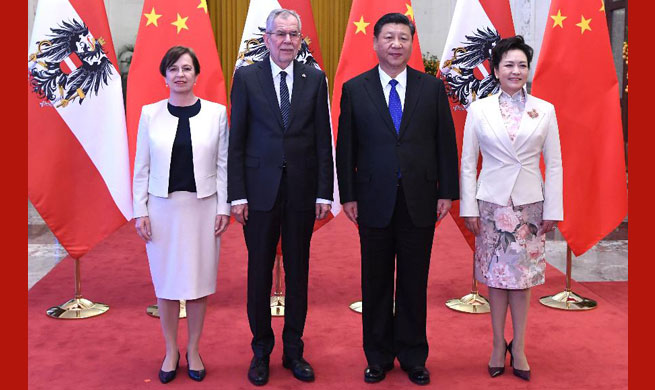by Xinhua writer Liu Xinyong
BEIJING, April 9 (Xinhua) -- The U.S. trade deficit with China has been one of the main excuses behind the Trump administration's unilateral decision to slap tariffs on 50 billion U.S. dollars of Chinese products.
"Now we have a Trade Deficit of $500 Billion a year," President Donald Trump said in a posting Wednesday, after the Office of the U.S. Trade Representative on Tuesday published a proposed list of products imported from China that could be subjected to additional tariffs.
"The U.S. is losing $500 Billion a year, and has been losing Billions of Dollars for decades," he tweeted in another posting Saturday.
As ever, his calculations were wrong in every sense.
NUMBERS CAN LIE
"Trump continues to single out China as the villain in the great American tragedy, when in fact he should take a careful look in the mirror," said Stephen Roach, a senior fellow at the Yale University Jackson Institute for Global Affairs, in a new article.
"First, he continues to insist that the U.S.-China trade deficit is 500 billion dollars, fully one-third larger than the actual figure of 375 billion dollars published by the Commerce Department," Roach said.
In 2017, total goods trade deficit of the United States stood at 796.2 billion dollars, among which 375.2 billion dollars came from trade with China, according to U.S. data.
China's General Administration of Customs data showed the country's goods trade surplus at 275.8 billion dollars, about 100 billion dollars less than the U.S. figure.
Despite the discrepancy, neither the United States nor Chinese figures came any closer to Trump's calculation.
Data from the Organisation for Economic Co-operation and Development (OECD) and the World Trade Organization suggest at least 40 percent of this bilateral imbalance reflects supply-chain effects of components and parts that are produced outside of China but assembled inside China, according to Roach.
"That means, based on the value added of what is actually produced in China -- the essence of the alleged China threat -- that the 47 percent share of the U.S. deficit ascribed to China would be reduced to around 28 percent," Roach said.
CALCULATION METHODS MATTER
Take the iPhone X for example, although a number of the devices are exported from China to the United States, only about 3 to 6 percent of the manufacturing cost originate in China.
"Our exported products used materials and parts imported from other countries, so not all of the exported value is added in China," said Bai Ming, researcher with the Chinese Academy of International Trade and Economic Cooperation.
Using the value-added approach is more precise than the traditional trade volume approach in "evaluating the trade interests between economies," Bai said.
For a long time, China stayed on the lower end of the global value chain, resulting in limited actual gains from the trade process in spite of huge trade figures.
Last year, 61 percent of China's goods trade surplus came from processing trade.
Using the value-added method, China's surplus with the United States will drop by 44.4 percent from the traditional method, according to a report from the Chinese Academy of Social Sciences.
WINNER OR LOSER?
Traditional numbers also fail to capture business interests from subsidiaries of multinational companies.
"Trade is not just export and import, but should also take into account the local sales of multinationals," said Zhang Monan, researcher with China Center for International Economic Exchanges.
Chinese customs data showed some 59 percent of the country's goods trade surplus with the United States came from the export and import of foreign-invested companies.
U.S. goods trade deficit with China does not show the full picture of China-U.S. economic ties, according to a Deutsche Bank research report.
There were 310 million active iPhones in use in China in 2016, but they cannot be found in U.S.-China bilateral trade, because Apple, like many other U.S. companies, has subsidiaries in China.
"From an international trade perspective, iPhones sold by Apple's Chinese subsidiaries are not counted as imports. But from an economic and financial perspective, the iPhone is a U.S. product, and the United States benefits the most from it," the report said.
In 2015, China-U.S. trade and investment created about 2.6 million U.S. jobs and contributed 216 billion dollars to the economic growth of the United States, according to the Chinese Ministry of Commerce.
However, the U.S. administration last week upped the ante by threatening additional tariffs on 100 billion dollars of products from China.
Roach described the U.S. "China-bashing" as "protectionism in the face of widening trade deficits."
"In the 1930s, protectionist tariffs and a global trade war exacerbated the Great Depression and destabilized the international order. Sadly, one of the most painful lessons of modern history is now at risk of being ignored," Roach said.

















